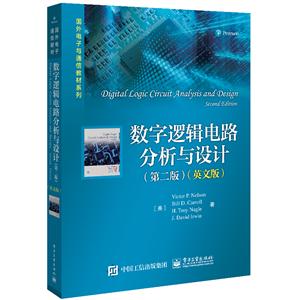-
>
湖南省志(1978-2002)?铁路志
-
>
公路车宝典(ZINN的公路车维修与保养秘籍)
-
>
晶体管电路设计(下)
-
>
基于个性化设计策略的智能交通系统关键技术
-
>
德国克虏伯与晚清火:贸易与仿制模式下的技术转移
-
>
花样百出:贵州少数民族图案填色
-
>
识木:全球220种木材图鉴
国外电子与通信教材系列数字逻辑电路分析与设计(第2版)(英文版)/(美)VictorP.Nelson 版权信息
- ISBN:9787121398704
- 条形码:9787121398704 ; 978-7-121-39870-4
- 装帧:一般胶版纸
- 册数:暂无
- 重量:暂无
- 所属分类:>>
国外电子与通信教材系列数字逻辑电路分析与设计(第2版)(英文版)/(美)VictorP.Nelson 本书特色
* 基本概念和理论的讲解具有一定的广度与深度。 * 非常实用的设计方法。 * 超过250个工作实例。 * 提供大量习题,难易程度不同。 * 基本概念和理论的讲解具有一定的广度与深度。 * 非常实用的设计方法。 * 超过250个工作实例。 * 提供大量习题,难易程度不同。
国外电子与通信教材系列数字逻辑电路分析与设计(第2版)(英文版)/(美)VictorP.Nelson 内容简介
本书以介绍数字设计的基础知识以及丰富案例为主要特色,并在版的基础上进行了全面的修订与更新,更加突出了数字设计相关技术的应用。本书内容包括:计算机与数字系统,数制系统,逻辑电路与布尔代数,组合逻辑电路分析与设计,时序逻辑电路简介,同步时序逻辑电路分析与设计,异步时序逻辑电路分析与设计,可编程逻辑器件,数字系统设计。本书对基本概念和理论的讲解具有一定的广度与深度,同时添加了很好实用的设计方法。
国外电子与通信教材系列数字逻辑电路分析与设计(第2版)(英文版)/(美)VictorP.Nelson 目录
0 Computers and Digital Systems 1
Learning Objectives 1
0.1 A Brief History of Computing 1
0.1.1 Beginnings: Mechanical Computers 2
0.1.2 Early Electronic Computers 2
0.1.3 The First Four Generations of Computers 2
0.1.4 The Fifth Generation and Beyond 4
0.2 Digital Systems 4
0.2.1 Digital versus Analog Systems 5
0.2.2 Digital System Levels of Abstraction 5
0.3 Electronic Technologies 8
0.3.1 Moore’s “Law” 9
0.3.2 Fixed versus Programmable Logic 10
0.3.3 Microcontrollers 10
0.3.4 Design Evolution 10
0.4 Applications of Digital Systems 12
0.4.1 General-Purpose Digital Computers 12
0.4.2 Controllers 17
0.4.3 Internet of Things (IoT) 18
0.4.4 Interfacing 18
0.5 Summary and Review Questions 20
0.6 Collaboration Activities 20
References 21
1 Number Systems and Digital Codes 22
Learning Objectives 22
1.1 Number Systems 22
1.1.1 Positional and Polynomial Notations 23
1.1.2 Commonly Used Number Systems 23
1.2 Arithmetic 24
1.2.1 Binary Arithmetic 24
1.2.2 Hexadecimal Arithmetic 27
1.3 Base Conversions 29
1.3.1 Conversion Methods and Algorithms 29
1.3.2 Conversion between Base A and Base B When B = Ak 32
1.4 Signed Number Representation 33
1.4.1 Sign Magnitude Numbers 33
1.4.2 Complementary Number Systems 35
1.5 Digital Codes 45
1.5.1 Numeric Codes 46
1.5.2 Character and Other Codes 50
1.5.3 Error Detection and Correction Codes 53
1.6 Summary and Review Questions 58
1.7 Collaboration Activities 58
Problems 59
2 Logic Circuits and Boolean Algebra 61
Learning Objectives 61
2.1 Logic Gates and Logic Circuits 61
2.1.1 Truth Tables 61
2.1.2 Basic Logic Gates 62
2.1.3 Combinational Logic Circuits 65
2.1.4 Sequential Logic Circuits 68
2.2 Hardware Description Languages (HDLs) 69
2.2.1 Verilog 69
2.2.2 VHDL 70
2.3 Boolean Algebra 72
2.3.1 Postulates and Fundamental Theorems 72
2.3.2 Boolean (Logic) Functions and Equations 77
2.3.3 Minterms, Maxterms, and Canonical Forms 78
2.3.4 Incompletely Specified Functions (Don’t Cares) 81
2.4 Minimization of Logic Expressions 82
2.4.1 Minimization Goals and Methods 82
2.4.2 Karnaugh Maps (K-Maps) 84
2.4.3 Minimization of Logic Expressions Using K-Maps 91
2.4.4 Quine–McCluskey Method 106
2.5 Summary and Review Questions 111
2.6 Collaboration Activities 112
Problems 113
3 Combinational Logic Circuit Design and Analysis 123
Learning Objectives 123
3.1 Design of Combinational Logic Circuits 123
3.1.1 AND–OR and NAND–NAND Circuits 124
3.1.2 OR–AND and NOR–NOR Circuits 125
3.1.3 Two-Level Circuits 126
3.1.4 Multilevel Circuits and Factoring 128
3.1.5 EXCLUSIVE-OR (XOR) Circuits 131
3.2 Analysis of Combinational Circuits 134
3.2.1 Boolean Algebra 134
3.2.2 Truth Tables 136
3.2.3 Timing Diagrams 137
3.2.4 Positive and Negative Logic 142
3.3 Design Using Higher-Level Devices 143
3.3.1 Decoders 143
3.3.2 Encoders 155
3.3.3 Multiplexers and Demultiplexers 159
3.3.4 Arithmetic Circuits 169
3.4 Summative Design Examples 182
3.4.1 Design Flow 182
3.4.2 Bank Security-Lock Controller 182
3.4.3 Seven-Segment Display Decoder 186
3.4.4 Four-Function Arithmetic Logic Unit (add, subtract, AND, XOR) 192
3.4.5 Binary Array Multiplier 196
3.5 Summary and Review Questions 200
3.6 Collaboration Activities 201
Problems 202
4 Introduction to Sequential Circuits 213
Learning Objectives 213
4.1 Models and Classes of Sequential Circuits 214
4.1.1 Finite-State Machines 214
4.1.2 State Diagrams and State Tables 216
4.1.3 Algorithmic State Machines 219
4.2 Memory Devices 221
4.2.1 Latches 222
4.2.2 Flip-Flops 234
4.2.3 Latch and Flip-Flop Summary 244
4.3 Registers 244
4.4 Shift Registers 248
4.5 Counters 253
4.5.1 Synchronous Binary Counters 254
4.5.2 Asynchronous Binary Counters 257
4.5.3 Modulo-N Counters 258
4.5.4 Ring and Twisted-Ring Counters 263
4.6 Summative Design Examples 272
4.6.1 Register File 272
4.6.2 Multiphase Clock 273
4.6.3 Digital Timer 275
4.6.4 Programmable Baud Rate Generator 278
4.7 Summary and Review Questions 281
References 281
4.8 Collaboration Activities 282
Problems 283
5 Synchronous Sequential Logic Circuit Analysis and Design 291
Learning Objectives 291
5.1 Analysis of Sequential Circuits 291
5.1.1 Circ
国外电子与通信教材系列数字逻辑电路分析与设计(第2版)(英文版)/(美)VictorP.Nelson 作者简介
本书以介绍数字设计的基础知识以及丰富案例为主要特色,并在第一版的基础上进行了全面的修订与更新,更加突出了数字设计相关技术的应用。本书内容包括:计算机与数字系统,数制系统,逻辑电路与布尔代数,组合逻辑电路分析与设计,时序逻辑电路简介,同步时序逻辑电路分析与设计,异步时序逻辑电路分析与设计,可编程逻辑器件,数字系统设计。本书对基本概念和理论的讲解具有一定的广度与深度,同时添加了非常实用的设计方法。
-
基于融合表征的多视图学习方法
¥23¥30 -
ANSYS电磁兼容仿真与场景应用案例实战
¥81.8¥109 -
业余无线电通信 第五版
¥62.6¥79 -
现代微波技术基础
¥14.5¥21 -
4.23文创礼盒A款--“作家言我精神状态”
¥42.3¥206 -
4.23文创礼盒B款--“作家言我精神状态”
¥42.3¥206





















